March 4, 2017 show
Shortridge High School history
It's the oldest public high school in the Indiana capital, having evolved from what opened as Indianapolis High School in 1864.
 Shortridge High School gained a national reputation for academic excellence by the 1920s. Students produced the first daily high school newspaper in the country: the acclaimed Daily Echo. Shortridge High School gained a national reputation for academic excellence by the 1920s. Students produced the first daily high school newspaper in the country: the acclaimed Daily Echo.
Distinguished graduates of Shortridge, which moved from various locations downtown to its current site at North Meridian and 34th Streets during the late 1920s, have included dozens of notables in politics, literature, business and the arts. They include Kurt Vonnegut (class of '40); former U.S. Sen. Richard Lugar and Dan Wakefield (both class of '50); TV writer Madelyn Pugh Davis (class of '38), co-creator of "I Love Lucy;" former U.S. Congressman Andy Jacobs (class of '49), and Anita DeFrantz (class of '70), the first woman and African-American on the powerful International Olympics Committee.
Today, Shortridge is an International Baccalaureate (IB) school, having reopened as a high school in 2009. In a controversial decision by Indianapolis Public Schools, Shortridge had been converted to a junior high school in 1981, then a middle school.
To explore the rich heritage of Shortridge, Nelson will be joined by four guests:
 Shane O'Day, the current principal, who will share insights about the IB program (described as "academically challenging and balanced"), as well as details about a museum being created at Shortridge. The school's name was changed from Indianapolis High School in the 1890s to honor Abram Shortridge (1833-1919), the city's first school superintendent. Shane O'Day, the current principal, who will share insights about the IB program (described as "academically challenging and balanced"), as well as details about a museum being created at Shortridge. The school's name was changed from Indianapolis High School in the 1890s to honor Abram Shortridge (1833-1919), the city's first school superintendent.- Sharon Butsch Freeland, an Indianapolis historian, researcher and member of Shortridge's class of 1965. She is a board member of Historic Urban Neighborhoods of Indianapolis. Sharon has written about one of the earliest notable graduates of her alma mater: George Andrew Reisner Jr., who ranked No. 1 in the class of 1885 and became a top Egyptologist hailed as "one of the most important figures in modern scientific archaeology."
- Civic leader Ted Boehm, a former Indiana Supreme Court justice. A member of Shortridge's class of '56, Ted Boehm is a partner at the law firm of Hoover Hull Turner; previously, he was managing partner of Baker & Daniels.
- And Kevin Grau, a historian and researcher; he is the parent of a current Shortridge student and an adviser to the school's archives club.
"I have always wanted to find out how the Shortridge mystique was established," wrote the late Laura Gaus, the author of Shortridge High School, 1864-1981. Her book opens by describing public education in Indianapolis before 1864 as a "wilderness." Until the opening of Indianapolis High School, education at the secondary school level in the Hoosier capital was limited to a few private academies.
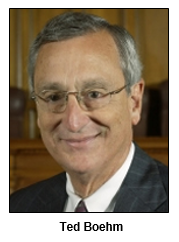 Our guest Sharon Butsch Freeland, who has researched the various early locations for Indianapolis (later Shortridge) High School, notes that it initially was housed in a former IPS grade school at Vermont and New Jersey Streets. (Today that location is the parking lot for a Marsh Supermarket.) Our guest Sharon Butsch Freeland, who has researched the various early locations for Indianapolis (later Shortridge) High School, notes that it initially was housed in a former IPS grade school at Vermont and New Jersey Streets. (Today that location is the parking lot for a Marsh Supermarket.)
Although the high school moved to various other sites during the 1800s, the most significant (from 1885 until the opening of the current location in 1928) was in the 500 block of North Pennsylvania Street. Today the site is occupied by the Minton-Capehart Federal Building, 575 N. Pennsylvania.
At the current location, Shortridge became an academic and athletic powerhouse, winning city football championships. Vonnegut, Madelyn Pugh and other future professional writers were on the staff of the Echo; Lugar and Wakefield wrote rival sports columns. In 1970, Wakefield used Shortridge as the inspiration for the high 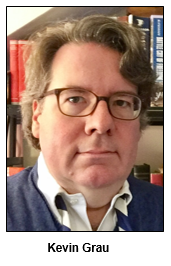 school, which he called "Shortley," in his national bestseller Going All the Way. school, which he called "Shortley," in his national bestseller Going All the Way.
According to Shortridge High School, 1864-1981, it may have been the top high school in the country during World War II for student-led war bond drives. A spectacularly successful drive resulted in the sale of more than $1.3 million in war bonds, "enough to purchase, in addition to a pursuit plane, two B-17 flying fortresses, which were appropriately christened Blue Devils." (The Blue Devils is the Shortridge mascot).
Other history facts:
- In 1964, Shortridge singers became the first high school group to appear at Clowes Hall.
- During the early 1960s, our guest Ted Boehm was a law clerk for U.S. Supreme Court Chief Justice Earl Warren and other justices. Before serving on the Indiana Supreme Court, he was the first CEO of the Indiana Sports Corp. and the chairman of the organizing committee of the 1987 Pan American Games, which Indy hosted.
- Although Shortridge faced challenges after reopening as a high school in 2009, the IB program introduced a few years ago - with high standards for student achievement - has been drawing praise. Our guest Shane O'Day, the principal, has overseen schools offering the IB program in China, Mexico and elsewhere overseas.
- A digitized collection of Shortridge yearbooks is available online via the Indianapolis Public Library's Digital Indy collections.
History Mystery
Ever since the late 1920s, the mascot for sports teams at Shortridge High School has been the Blue Devils. The mascot for Shortridge - where the school colors are blue and white - was derived from a World War I-era infantry division known as the Blue Devils.
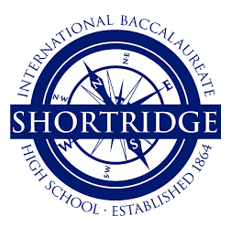 Before that became the mascot for Shortridge, though, the high school had another mascot, an animal, which served as the school's symbol during the mid-1920s. Before that became the mascot for Shortridge, though, the high school had another mascot, an animal, which served as the school's symbol during the mid-1920s.
Question: What was it?
The call-in number is (317) 788-3314. Please do not call in to the show until you hear Nelson pose the question on the air, and please do not try to win the prize if you have won any other prize on WICR during the last two months. You must be willing to give your name and address to our engineer and be willing to be placed on the air, and you must answer the question on the air.
The prize is a pair of passes to the Indiana Experience exhibit at the Eugene and Marilyn Glick Indiana History Center, courtesy of the Indiana Historical Society, and a pair of passes to GlowGolf, the miniature golf course (actually there are two!) at the Circle Centre Mall in downtown Indianapolis, courtesy of GlowGolf.
9 years on the air!
Nine-year soiree makes a little Hoosier history
On Feb. 23, a star-studded gathering of listeners, fans, show guests and civic leaders celebrated nine years on the air for Hoosier History Live. The Indiana Landmarks Center teemed with history-minded folks, and in some cases folks from history, including President Benjamin Harrison and suffragist May Wright Sewall.
Congratulations abounded. Indianapolis Mayor Joe Hogsett dropped in to say a few kind words to his old college pal, our host Nelson Price. Here's a mayoral tidbit: Nelson's father was a mentor for young lawyer Hogsett, who went on to become Indiana secretary of state and a U.S. attorney.
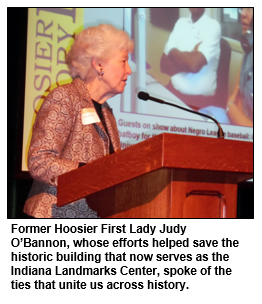 Judy O'Bannon gave a tour de force talk on how knowing our history together unites us across time. O'Bannon was a member of the Central Avenue United Methodist Church, the denomination that originally constructed the building that today, after years of painstaking renovation, houses the Indiana Landmarks Center. The very floors are history, she noted, recalling the lives lived and joined and mourned during the time of the church and now on into the future. Judy O'Bannon gave a tour de force talk on how knowing our history together unites us across time. O'Bannon was a member of the Central Avenue United Methodist Church, the denomination that originally constructed the building that today, after years of painstaking renovation, houses the Indiana Landmarks Center. The very floors are history, she noted, recalling the lives lived and joined and mourned during the time of the church and now on into the future.
The WICR 88.7FM program director, Henri Pensis, offered words of encouragement to the team - and yet another good reason to always listen to the show - saying that as a new arrival to the state he continues to learn much about Indiana from the show.
The party was made possible by our sponsors, Core Redevelopment and MBP Distinctive Catering.
Thanks from Nelson and the team to Garry Chilluffo, party organizer extraordinaire, and also to Gary BraVard, event planner, for helping to put the dazzle in this anniversary soiree.
All we at Hoosier History Live can say is ... look out for our 10-year affair. It is sure to be a doozy.
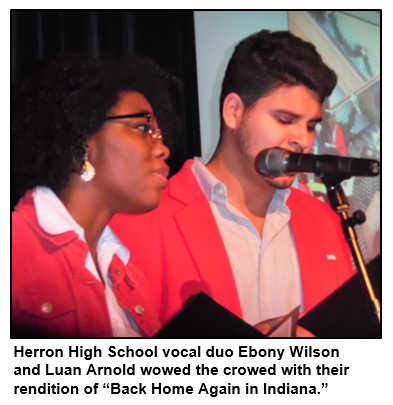 As per usual, Nelson and his quiz-show assistant Molly Head, our producer, entertained the crowd with fresh History Mystery questions and fabulous prizes. With so many authors and experts in the crowd, Nelson had to disqualify some from answering certain questions. As per usual, Nelson and his quiz-show assistant Molly Head, our producer, entertained the crowd with fresh History Mystery questions and fabulous prizes. With so many authors and experts in the crowd, Nelson had to disqualify some from answering certain questions.
"I drew this question from your book," Nelson told Glory-June Greiff. No prize on that one for her!
Performances included the Herron High School String Quartet, acoustic music from PrairieTown with Dan Wethington and Janet Gilray, piano by Shirley Judkins and a vocal performance of "Back Home Again in Indiana" by Herron High School duo Ebony and Luan.
On hand for a scan-a-thon were our friends from the Indiana Album. They displayed some of their growing collection of archival images from Indiana's past and present.
Photos are rolling in. Won't you please send us any good ones to news@hoosierhistorylive.org?
Thanks to all who supported and attended the party. Now let's go make some more Hoosier history!
Hoosier History Live seeks restaurant partner
 We like to treat our show guests to lunch after the live show on Saturday at noon. Hoosier History Live is seeking a restaurant near the University of Indianapolis, perhaps in Fountain Square or Downtown, that would like to treat our guests to lunch in exchange for underwriting, i.e. logos on the Hoosier History Live website and newsletter and live reads in the show. We like to treat our show guests to lunch after the live show on Saturday at noon. Hoosier History Live is seeking a restaurant near the University of Indianapolis, perhaps in Fountain Square or Downtown, that would like to treat our guests to lunch in exchange for underwriting, i.e. logos on the Hoosier History Live website and newsletter and live reads in the show.
Are you a restaurant owner or manager who would like to host us on Saturday afternoons? Interesting guests and lots of lively conversation is guaranteed.
For more information, contact molly@hoosierhistorylive.org. In fact, for all underwriting inquiries, contact Molly! We can't do it without your support.
Your Hoosier History Live team,
Nelson Price, host and creative director
Molly Head, producer, (317)
927-9101
Richard Sullivan, webmaster and tech director
Pam Fraizer, graphic designer
Garry Chilluffo, media+development director
Michael Armbruster, newsletter editor
www.hoosierhistorylive.org

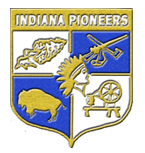  
 
 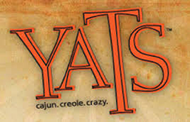

Please tell our sponsors that you appreciate their support: Indiana Authors Award | Indiana Historical Society | Indiana Landmarks | Lucas Oil | MBP Catering | Shirley Brothers Mortuaries & Crematory | Story Inn | Yats Cajun Creole Restaurant
  Acknowledgments to Monomedia, Visit Indy, WICR-FM, Fraizer Designs, Heritage Photo & Research Services, Derrick Lowhorn and many other individuals and organizations. We are an independently produced program and are self-supporting through organizational sponsorships and individual contributions. We do not receive any government funding. Visit our website to learn how you can support us financially. Also, see our Twitter feed and our Facebook page for regular updates. Acknowledgments to Monomedia, Visit Indy, WICR-FM, Fraizer Designs, Heritage Photo & Research Services, Derrick Lowhorn and many other individuals and organizations. We are an independently produced program and are self-supporting through organizational sponsorships and individual contributions. We do not receive any government funding. Visit our website to learn how you can support us financially. Also, see our Twitter feed and our Facebook page for regular updates.
Thank you!
We'd like to thank the following recent, new, and renewal contributors whose donations help make this show possible!
- John and Diane Iozzo.
- Margaret Smith.
- Tom and Linda Castaldi, Fort Wayne.
- Peggy Hollingsworth, Connersville.
- Jane "Janie" Hodge.
- Lorraine and Richard Vavul.
- Kathleen Angelone.
- Richard Vonnegut.
- Jim and Marjorie Kienle.
- Georgia Cravey and Jim Lingenfelter.
- Dennis Arbuckle.
- Rita Kohn.
- Don Willsey and Judy O'Bannon.
- John and Lena Snethen.
- Juliet Emanuel, New York City.
- Sharon Butsch Freeland.

Your donation helps keep Hoosier History Live on the air, on the web and in your inbox!
|
March 11, 2017 show - upcoming
Historic women in science
In sciences ranging from physics to home economics, Hoosier women became pioneers during the early and mid-1900s.
But they confronted myriad challenges, and their trail blazing often has been overlooked.
Hoosier History Live will strive to rectify that as we salute Women's History Month by spotlighting the innovations of - and obstacles confronted by - a physicist from southern Indiana who pioneered new theories (but whose career was stalled because of McCarthyism during the Cold War) and two women associated with Purdue University who were pioneers in "bringing science into the home." One of them traveled across the Hoosier state during the World War I era to share research with farm women.
Nelson's guests will include:
 Jill Weiss, digital outreach manager at the Indiana Historical Bureau. She will share insights about Melba Phillips (1907-2004), a native of Hazleton, Ind., who became an internationally acclaimed physicist, worked to improve science education and, according to Jill, "advocated for women's place at the forefront of science research." Following World War II, Phillips and other scientists organized to prevent future nuclear wars. She was fired from university posts, though, after being accused of advocating subversive positions. Jill Weiss, digital outreach manager at the Indiana Historical Bureau. She will share insights about Melba Phillips (1907-2004), a native of Hazleton, Ind., who became an internationally acclaimed physicist, worked to improve science education and, according to Jill, "advocated for women's place at the forefront of science research." Following World War II, Phillips and other scientists organized to prevent future nuclear wars. She was fired from university posts, though, after being accused of advocating subversive positions.- And Angie Klink, a Lafayette-based author and historian whose eight books include Divided Paths, Common Ground (Purdue University Press, 2011). It is a dual biography of Mary Matthews, who became the first dean of home economics at Purdue University, and Lella Gaddis, the first state leader of home demonstrations in agricultural extension.
"She hit the road to take research and knowledge ... directly to farm women who often were isolated," Angie notes, referring to Gaddis. Prior to her outreach, what farm women knew about food preservation (a particularly important topic during World War I when meat, sugar and other goods were in high demand), sanitation and nutrition often had just been "handed down by word-of-mouth from their mothers."
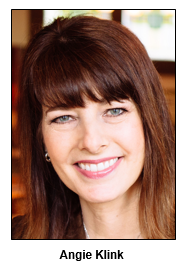 When Matthews was initially appointed a department chair of home economics in 1912 prior to becoming Purdue's first dean of the subject, "she had little support from the men in power at Purdue," Angie writes. When Matthews was initially appointed a department chair of home economics in 1912 prior to becoming Purdue's first dean of the subject, "she had little support from the men in power at Purdue," Angie writes.
Melba Phillips, the physicist, encountered enormous challenges during her long career, but rebounded and became the first woman president of the American Association of Physics Teachers in 1966.
More than 20 years later, according to a blog that our guest Jill Weiss has written for the Historical Bureau, Brooklyn College publicly apologized for having fired Phillips during the 1950s. Eventually, the college even created a scholarship in her name.
Phillips, who had studied under Robert Oppenheimer and went on to write two physics textbooks, was living in Petersburg, Ind., when she died at age 97. During the 1950s, she had refused to testify before a subcommittee of the US Senate Judiciary Committee that was investigating internal security.
Jill's blog about her is titled "Melba Phillips: Leader in Science and Conscience." Phillips also will be the subject of an upcoming episode of the new IHB podcast Talking Hoosier History, which Jill helps produce.
Some of the women pioneers in science will be explored during a Hoosier Women at Work conference on April 1 hosted by the Indiana Historical Bureau, 315 W. Ohio St. in Indianapolis.
© 2017 Hoosier History Live. All rights reserved.
|